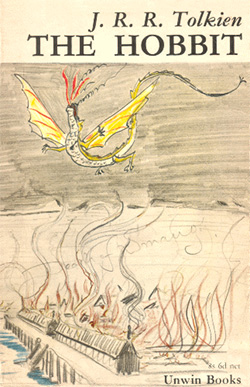It could have been one of many things. I guess that you could call the Hundred Acre Wood a well-formed universe: after all, it has maps, hums to hum when walking through, and so on. But The Hobbit understandably stood out when I was little.
Not one map but many. Not just hums, but developed songs; beings with other languages, other scripts. Humans, yes, but somewhat different to us – and not that sympathetic as characters.
Humans alongside many others, with their own customs, their own strengths and weaknesses and prejudices and pigheadedness. Some so different that they need two books, and extra side-quests, to learn respect for each other.
My dad read The Hobbit to me. It may have been a gentle intro to science fiction – if so, it worked. I read The Lord of the Rings for myself – his copies.

When I was looking to buy a copy of The Hobbit for someone, we hunted extra hard for one with the pencil sketch cover of Smaug on the front. There is a certain fascination of that subdued cover, set against the richness of the story.
At first reading, you are propelled by the story. I remember being caught up in the plot, and the separate set pieces of the journey: meeting the trolls, the journey through the forest of spiders. And above all, Bilbo, trapped in the dark, desperately riddling with Gollum, and coming across the ring.
Later, you realise the extra layers within the wider universe: the environmentalism; the struggle between leaving behind one of your own – or what if they want to remain? The emotions become writ larger: fear, greed, pride, desperation, daring.
It is no wonder that ‘universe epics’ are so popular, in different settings. There is both the potential for many things to happen, and the growing internal logic: what choices a character may or may not make, because of what we know about the universe.
I’ve visited a fair few of universes over time. The desert world of Dune. The Harry Potter series, with everyday reality existing alongside Harry’s magical locations. Equally, Katie Morag’s island of Struay (again with map, and similarities with certain real islands we hold dear).
TV world is equally enamoured with its universes: whether Downton or Coronation Street, The West Wing or Dr Who, and many more.
For myself, I’m still looking towards writing shorter pieces – so blog writing is good training really. But secretly, I harbour a hope that a universe will some day unfold itself to me, and I will discover it too as I write.